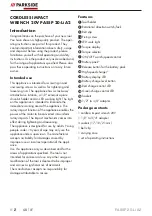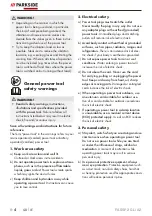
PASSP 20-Li A2
GB
│
IE
│
5
■
c)
Prevent unintentional starting. Ensure the
switch is in the off-position before connecting
to power source and/or battery pack, picking
up or carrying the tool.
Carrying power tools
with your finger on the switch or energising
power tools that have the switch on invites
accidents.
d)
Remove any adjusting key or wrench before
turning the power tool on.
A wrench or a key
left attached to a rotating part of the power tool
may result in personal injury.
e)
Do not overreach. Keep proper footing and
balance at all times.
This enables better control
of the power tool in unexpected situations.
f)
Dress properly. Do not wear loose clothing or
jewellery. Keep your hair and clothing away
from moving parts.
Loose clothes, jewellery or
long hair can be caught in moving parts.
g)
If devices are provided for the connection of
dust extraction and collection facilities, ensure
these are connected and properly used.
Use of dust collection can reduce dust-related
hazards.
h)
Do not allow yourself to get lulled into a false
sense of security and do not ignore the safety
rules for power tools, even if you are familiar
with the power tool after repeated use.
A careless action can cause severe injury within
a fraction of a second.
4. Power tool use and care
a)
Do not force the power tool. Use the correct
power tool for your application.
The correct
power tool will do the job better and safer at
the rate for which it was designed.
b)
Do not use the power tool if the switch does
not turn it on and off.
Any power tool that
cannot be controlled with the switch is
dangerous and must be repaired.
c)
Disconnect the plug from the power source
and/or remove the battery pack, if detachable,
from the power tool before making any adjust-
ments, changing accessories, or storing power
tools.
Such preventive safety measures reduce
the risk of starting the power tool accidentally.
d)
Store idle power tools out of the reach of
children and do not allow persons unfamiliar
with the power tool or these instructions to
operate the power tool.
Power tools are
dangerous in the hands of untrained users.
e)
Maintain power tools and accessories. Check
for misalignment or binding of moving parts,
breakage of parts and any other condition
that may affect the power tool’s operation.
If damaged, have the power tool repaired
before use.
Many accidents are caused by
poorly maintained power tools.
f)
Keep cutting tools sharp and clean.
Properly
maintained cutting tools with sharp cutting edges
are less likely to bind and are easier to control.
g)
Use the power tool, accessories and accessory
tools etc. in accordance with these instructions,
taking into account the working conditions and
the work to be performed.
Use of the power
tool for operations different from those intended
could result in a hazardous situation.
h)
Keep handles and grasping surfaces dry,
clean and free from oil and grease.
Slippery
handles and grasping surfaces do not allow
for safe handling and control of the tool in un ex-
pected situations.
5. Use and handling of the cordless
electrical power tool
a)
Charge a rechargeable battery using only the
charger recommended by the manufacturer.
Chargers are often designed for a particular
type of rechargeable battery unit. There is the
danger of fire if other types of rechargeable
battery units are used.
b)
Only the rechargeable battery units supplied
are to be used with an electrical power tool.
The use of other rechargeable battery units may
lead to the danger of injury or fire.
c)
When they are not being used, store
rechargeable battery units away from paper-
clips, coins, keys, nails, screws or other small
metal objects that could cause the contacts to
be bridged.
Short-circuiting the contacts of a
rechargeable battery unit may result in heat
damage or fire.
Summary of Contents for PASSP 20-Li A2
Page 3: ...A 3a...
Page 4: ...20V max 18V...
Page 19: ...PASSP 20 Li A2 14 GB IE...
Page 49: ...PASSP 20 Li A2 44 FR BE...
Page 77: ...PASSP 20 Li A2 72 CZ...
Page 105: ...PASSP 20 Li A2 100 SK...
Page 133: ...PASSP 20 Li A2 128 DK...











































